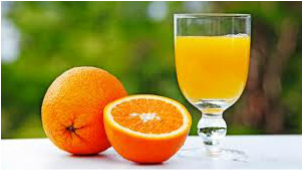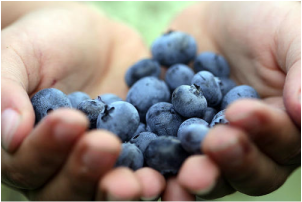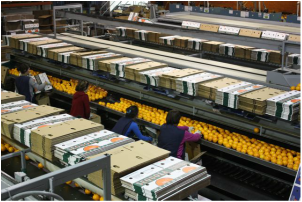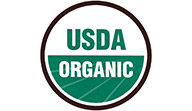OZONE FOR Produce Processing
INCREASED SHELF LIFE - ORGANIC CERTIFIED

Multiple Uses of Ozone to Improve the Safety of Fresh Fruits and Vegetables - Air & Water
In recent years, increasing attention has been focused on the safety of fruits and vegetables, and in particular on the intervention methods to reduce and eliminate human pathogens from fresh produce.
Traditional technology utilizes water with or without a sanitizing agent to wash fresh fruits and vegetables. Chlorine is the most widely used sanitizing agent available for fresh produce, but it has a limited effect in killing bacteria on fruit and vegetable surfaces. The most that can be expected at permitted concentrations is a 1 – to 2-log population reduction. Furthermore, the environmental and health communities have expressed concerns about the residual by-products of chlorine.
Ozone is the alternative treatment being used to improve food safety and extending the shelf life of produce by many days if not weeks. Research and commercial applications have verified that ozone can replace traditional sanitizing agents and provide other benefits. Processors worldwide have validated the use of ozone in the produce industry.
In recent years, increasing attention has been focused on the safety of fruits and vegetables, and in particular on the intervention methods to reduce and eliminate human pathogens from fresh produce.
Traditional technology utilizes water with or without a sanitizing agent to wash fresh fruits and vegetables. Chlorine is the most widely used sanitizing agent available for fresh produce, but it has a limited effect in killing bacteria on fruit and vegetable surfaces. The most that can be expected at permitted concentrations is a 1 – to 2-log population reduction. Furthermore, the environmental and health communities have expressed concerns about the residual by-products of chlorine.
Ozone is the alternative treatment being used to improve food safety and extending the shelf life of produce by many days if not weeks. Research and commercial applications have verified that ozone can replace traditional sanitizing agents and provide other benefits. Processors worldwide have validated the use of ozone in the produce industry.

Seeking an Alternative to Chemical Sanitizers
In the past two decades, the consumption of fresh fruits and vegetables in the U.S. has dramatically increased. In the meantime, the incidence of food borne illness due to food pathogens, chemicals, and waste-water has greatly increased. The has been drawing significant public and government attention.
The number of produce-associated food borne disease outbreaks and the number of cases of illness due to food pathogens have significantly increased in recent years. Moreover, losses in the fresh produce industry that are attributable to microbial spoilage between the time of harvest and consumption are estimated to be as high as 30%.
Chlorine is commonly used in the fresh fruit and vegetable industry to improve microbiological quality and control pathogens. However, many research studies have indicated that it is limited in its ability to kill bacteria on fruit and vegetable surfaces. Environmental and health organizations have expressed concerns with traditional sanitizing agents with respect to the formation of by-products, such as trihalomethanes (THMs) and other chemical residues formed in the wastewater returned to the environment. The produce industry is concerned about the possibility of future regulatory constraints on the use of chlorine as a sanitation agent.
Large amounts of pesticides have been used annually to control insects on fruits and vegetables. Current technologies cannot totally destroy the chemical residues on the surface of fruits and vegetables. These chemical residues may react with pesticides to form chemical by-products. These residues ultimately will be consumed by customers and may directly and indirectly affect public health. An accumulation of toxic chemicals in the environment has increased the national focus on the safe use of disinfectants, sanitizers, bleaching agents, and other chemicals in the food processing industry.
The produce industry is one of the largest and most important contributors to the world economy. It also generates billions of gallons of wastewater annually, with very high concentrations of bio-chemical oxygen demand (BOD) and chemical residues each year in the U.S. These waste waters have been linked to many serious problems such as cancer, fish death, water pollution, psychological and physiological diseases, and ecosystem damage. Moreover, the produce industry is paying heavy charges and surcharges for discharging wastewater into public water and wastewater treatment systems.
In the past two decades, the consumption of fresh fruits and vegetables in the U.S. has dramatically increased. In the meantime, the incidence of food borne illness due to food pathogens, chemicals, and waste-water has greatly increased. The has been drawing significant public and government attention.
The number of produce-associated food borne disease outbreaks and the number of cases of illness due to food pathogens have significantly increased in recent years. Moreover, losses in the fresh produce industry that are attributable to microbial spoilage between the time of harvest and consumption are estimated to be as high as 30%.
Chlorine is commonly used in the fresh fruit and vegetable industry to improve microbiological quality and control pathogens. However, many research studies have indicated that it is limited in its ability to kill bacteria on fruit and vegetable surfaces. Environmental and health organizations have expressed concerns with traditional sanitizing agents with respect to the formation of by-products, such as trihalomethanes (THMs) and other chemical residues formed in the wastewater returned to the environment. The produce industry is concerned about the possibility of future regulatory constraints on the use of chlorine as a sanitation agent.
Large amounts of pesticides have been used annually to control insects on fruits and vegetables. Current technologies cannot totally destroy the chemical residues on the surface of fruits and vegetables. These chemical residues may react with pesticides to form chemical by-products. These residues ultimately will be consumed by customers and may directly and indirectly affect public health. An accumulation of toxic chemicals in the environment has increased the national focus on the safe use of disinfectants, sanitizers, bleaching agents, and other chemicals in the food processing industry.
The produce industry is one of the largest and most important contributors to the world economy. It also generates billions of gallons of wastewater annually, with very high concentrations of bio-chemical oxygen demand (BOD) and chemical residues each year in the U.S. These waste waters have been linked to many serious problems such as cancer, fish death, water pollution, psychological and physiological diseases, and ecosystem damage. Moreover, the produce industry is paying heavy charges and surcharges for discharging wastewater into public water and wastewater treatment systems.

In response to the public concerns about food safety, the President of the United States and Congress issued a new federal initiative in 1997 – the President’s Food Safety Initiative – to improve the nation’s food safety system and our environment. One of the approaches to improve food safety is to identify an alternative sanitizer to replace traditional sanitizing agents which can also be used to treat or recycle food processing wastewater.
Research and commercial applications have indicated that ozone can replace chlorine with more benefits. In 1997, ozone was self-affirmed as Generally Recognized As Safe (GRAS) as a disinfectant for foods by an independent panel of experts sponsored by EPRI. This self-affirmation was timely for the produce industry in light of the President’s Fruit and Vegetable Safety Initiative. The produce industry is successfully using ozone all over the world.
Research and commercial applications have indicated that ozone can replace chlorine with more benefits. In 1997, ozone was self-affirmed as Generally Recognized As Safe (GRAS) as a disinfectant for foods by an independent panel of experts sponsored by EPRI. This self-affirmation was timely for the produce industry in light of the President’s Fruit and Vegetable Safety Initiative. The produce industry is successfully using ozone all over the world.






